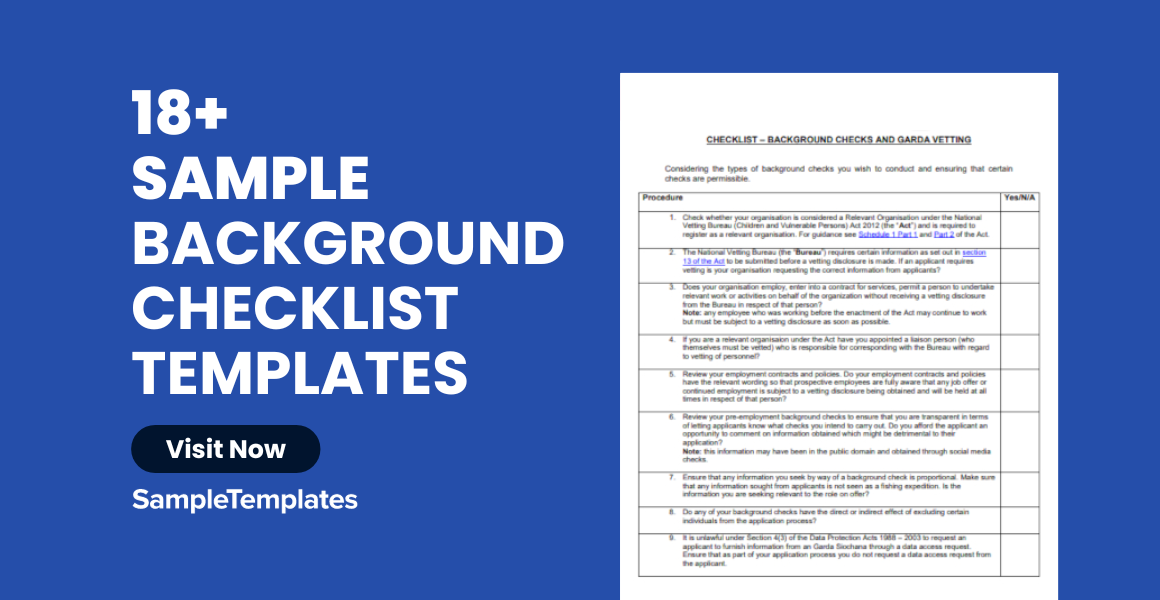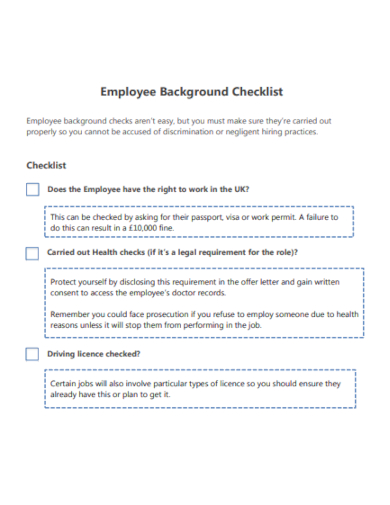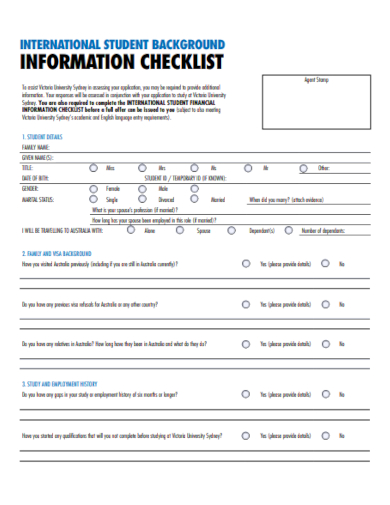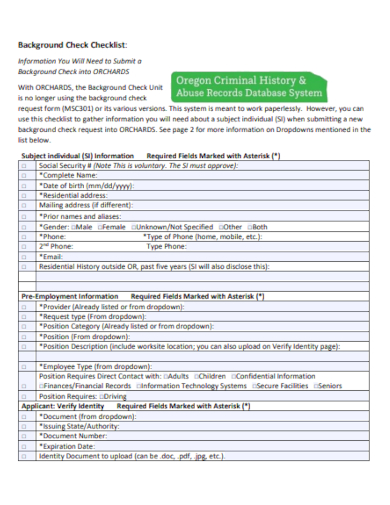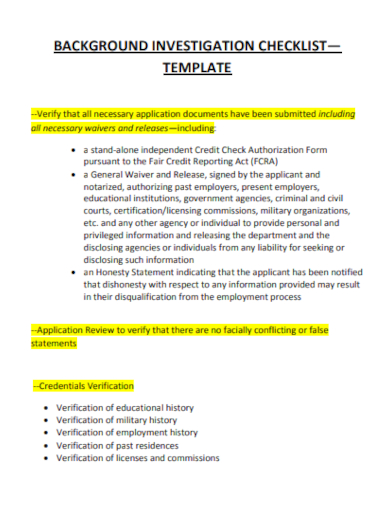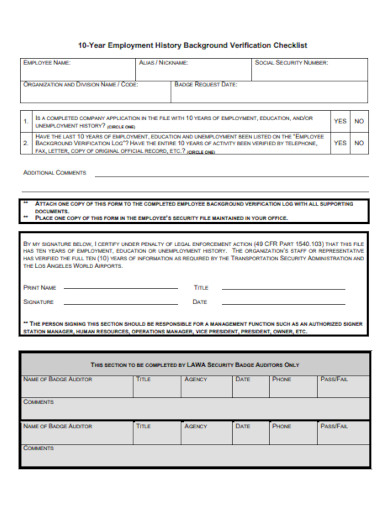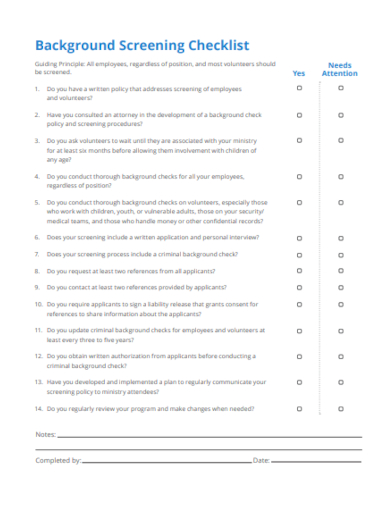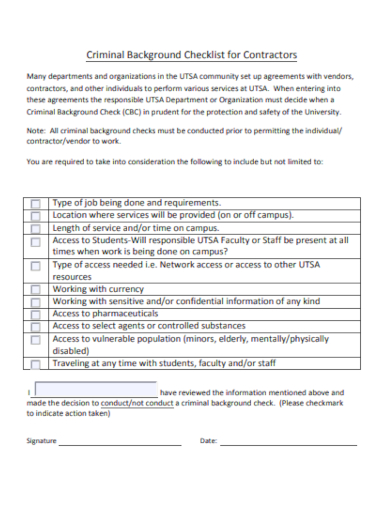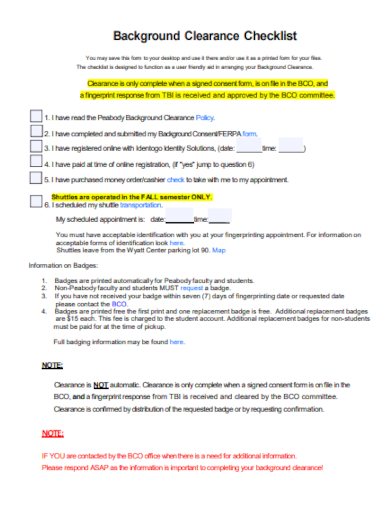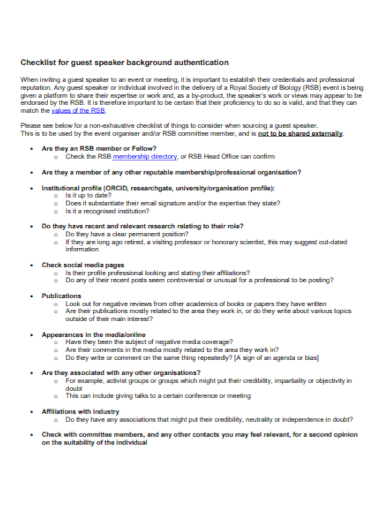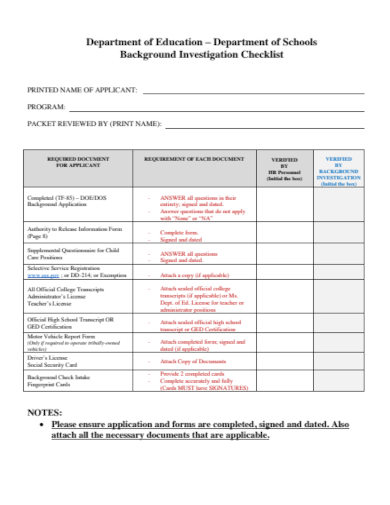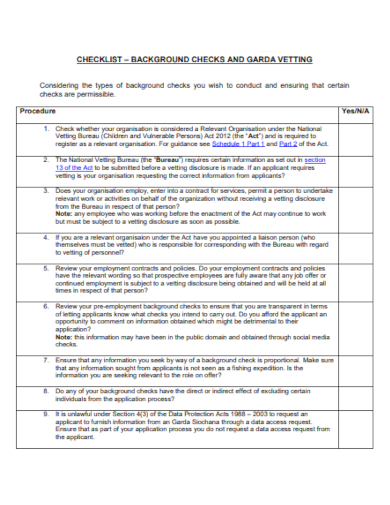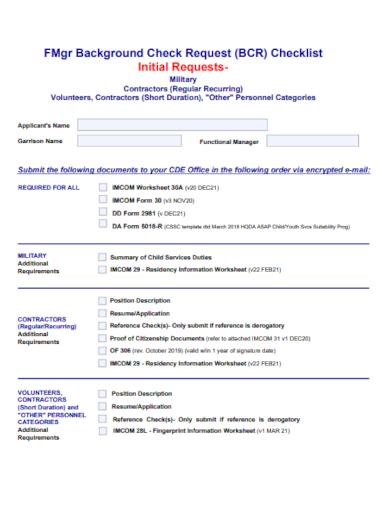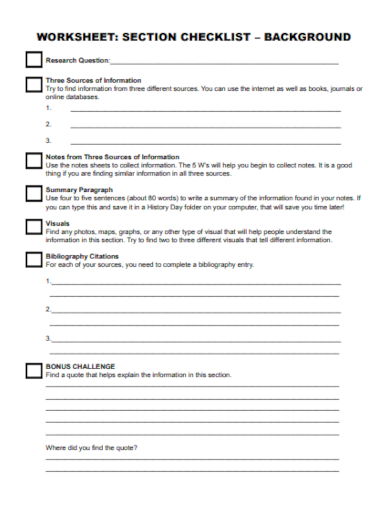Navigating the professional world or securing personal transactions often requires a robust ‘Background Checklist.’ This essential tool ensures due diligence, validating the integrity of individuals or entities you interact with. Optimized for today’s digitally-driven era, our comprehensive guide dives deep into the key components, ensuring you’re always a step ahead. Join us to master the art of thorough background vetting and make informed decisions with confidence. You can also see more templates like Blank Checklist Samples.
18+ Background Checklist Samples
1. Sample Checklist Template
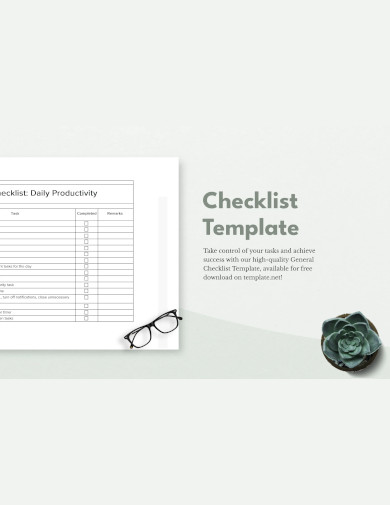
2. Basic Checklist Template
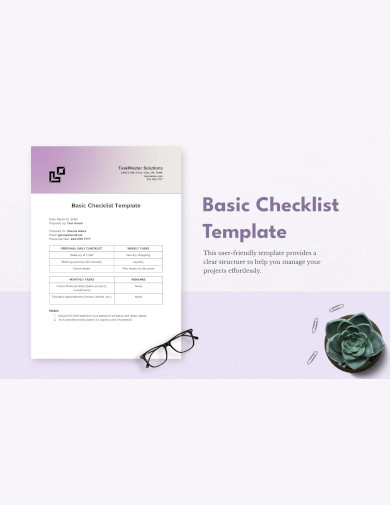
3. Formal Checklist Template
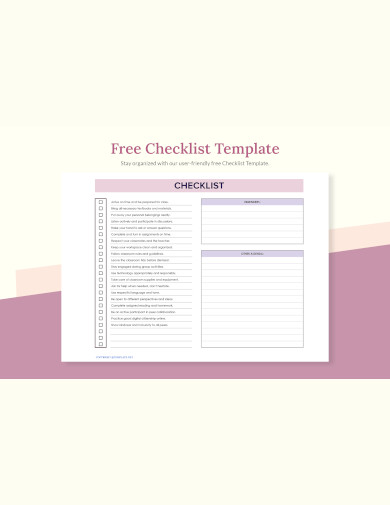
4. Printable Checklist Template
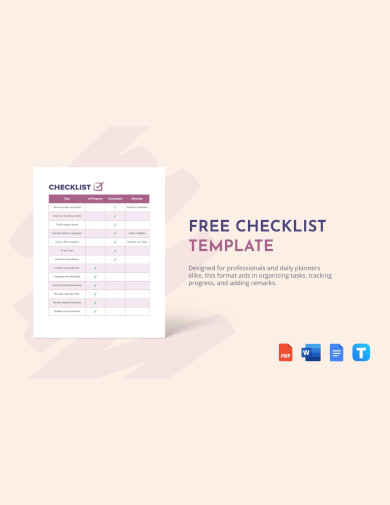
5. Sample Employee Background Checklist Template
What is a Background Checklist?
A background checklist is a systematic tool used by organizations, employers, landlords, and various institutions to ensure that individuals have been thoroughly vetted before engagement. Whether it’s hiring a new employee, renting a property to a tenant, or accepting a member into a sensitive community, these sample checklists help mitigate risks by ensuring that individuals meet specific criteria.
Understanding the Need for a Background Checklist
In today’s globalized world, interactions occur rapidly and often without personal acquaintance. This makes it crucial to establish trust swiftly and to ensure that interactions, particularly formal ones like employment or rental agreements, are grounded in reliability. For instance, an employer would want to ensure that a prospective employee doesn’t have a criminal record that might jeopardize workplace safety or integrity. Similarly, a landlord might want to make certain a potential tenant has a history of making timely rent payments and hasn’t been previously evicted.
Purpose and Application
The primary purpose of a background checklist is to establish trust and mitigate risks. It ensures that the individuals or entities being assessed meet the required criteria for a particular engagement, be it employment, housing, or financial transactions.
For example:
- Employers use it to verify the authenticity of an applicant’s qualifications, work history, and to check for any criminal records.
- Landlords might use it to sample review a prospective tenant’s rental history and financial responsibility.
- Financial institutions could use it to evaluate the creditworthiness of loan applicants.
Components of a Background Checklist
While the specifics can vary based on the purpose and requirements of the organization, a typical background checklist might include:
- Criminal Record Check: This delves into any criminal offenses an individual might have been involved in, from minor misdemeanors to major felonies. It’s crucial for roles that require high trust or deal with vulnerable populations.
- Employment Verification: To ascertain the validity of an individual’s work history, this check confirms the accuracy of past employers, job titles, and employment durations cited by a candidate.
- Educational Verification: A component that verifies the legitimacy of academic qualifications. It checks if the individual genuinely attended the specified educational institutions and achieved the claimed degrees or sample certificates.
- Credit Check: Primarily relevant for roles involving financial responsibilities or when renting properties, this check gauges an individual’s financial history, creditworthiness, and responsibility in managing debts.
- Reference Checks: This involves contacting provided references to gain insights into an individual’s character, reliability, work habits, and more. It’s a direct way to collect sample feedback from those who’ve had prior interactions with the individual.
Benefits of Using a Background Checklist
A well-structured background checklist offers a multitude of benefits:
- Risk Mitigation: It reduces the chances of engaging with individuals who might be detrimental to an organization or community.
- Trust Establishment: By verifying the backgrounds of individuals, organizations can build and maintain trust among their stakeholders.
- Compliance with Regulations: Especially in regulated industries, conducting background checks is often a legal requirement to ensure safety and security.
Why is it Necessary?
In an interconnected world where interactions often occur without personal acquaintance, a background checklist serves as a protective measure. You can also see more templates like Screening Checklist Samples. It aids in:
- Establishing trust quickly.
- Reducing the potential risks associated with fraudulent or misleading information.
- Ensuring safety, reliability, and credibility in professional and personal interactions.
6. Sample Student Background Checklist Template
7. Sample Background Check Checklist Template
8. Sample Background Investigation Checklist Template
9. Sample Background Verification Checklist Template
10. Sample Background Screening Checklist Template
11. Sample Background Compliance Checklist Template
12. Sample Contractor Background Checklist Template
13. Sample Production Agent Background Checklist Template
14. Sample Background Clearance Checklist Template
15. Sample Background Authentication Checklist Template
16. Sample School Background Checklist Template
17. Sample Background Procedure Checklist Template
18. Sample Background Check Request Checklist Template
19. Sample Background Worksheet Checklist Template
How do you Create a Background Checklist?
In today’s information-driven society, background checks have become an essential tool in many fields, from hiring processes to rental sample agreements. A well-organized background checklist can simplify and streamline this crucial task. If you’re new to this or looking to revamp your current procedure, here’s how you can create a comprehensive background checklist in five simple steps.
1. Determine the Purpose of the Checklist:
Purpose: Before diving into the specifics, it’s vital to determine the purpose of your background check. Are you hiring a new employee, checking a tenant’s history, or vetting a potential business partner? Each scenario will require different information. Example: For a potential tenant, you might prioritize previous rental histories and financial credit checks. For a job applicant, prior work experience and any criminal history could be paramount.
2. List Down the Essential Components:
Components: Once you’ve defined the purpose, list down the main components that will be part of the background check. Think of these as the primary categories you’ll be researching.Example: For a job applicant, essential components might include:
- Employment History
- Educational Background
- Criminal Records
- References
3. Dive Deep into Each Component:
Details: Each component will have various subcategories. This is where your printable checklist starts taking shape, turning from a broad overview into a detailed guide.Example: Under ‘Employment History’, you might include:
- Previous Employers
- Duration of Employment
- Job Responsibilities
- Reasons for Leaving
4. Determine Sources of Information:
Sources: Now that you’ve got your list, you need to know where you’ll obtain the information. Some data might be easily available online, while others might require signed permissions or specialized services.Example:
- For ‘Educational Background’, you can contact the university or institution directly or use verification services.
- ‘Criminal Records’ might require permissions and can be accessed via national or state databases.
5. Review and Update Regularly:
Maintenance: The world is constantly evolving, and so are regulations and best practices. Make it a point to review and update your checklist periodically to ensure it stays relevant and compliant.Example: If there are new data privacy laws implemented, they may limit or change the way you access certain information. Keeping abreast of these changes will help ensure that your background checks remain both thorough and legal.
In conclusion, a background checklist is an indispensable tool in today’s fast-paced world, helping ensure that engagements, whether they’re professional, personal, or transactional, are based on trust and reliability. While the process might seem tedious, the peace of mind and security it provides make it an invaluable asset. You can also see more templates like Project Checklists.
Related Posts
FREE 17+ Survey Checklist Samples in MS Word | Google Docs | PDF
FREE 18+ Internship Checklist Samples in MS Word | Google Docs | PDF
FREE 20+ Voluntary Checklist Samples in MS Word | Google Sheets | PDF
FREE 18+ Summary Checklist Samples in MS Word | Google Sheets | PDF
FREE 14+ Sponsorship Checklist Samples in MS Word | MS Excel | PDF
FREE 18+ Conference Checklist Samples in MS Word | Google Sheets | PDF
FREE 17+ Lesson Checklist Samples in MS Word | Google Sheets | PDF
FREE 18+ Progress Checklist Samples in MS Word | Google Docs | PDF
FREE 18+ Enrollment Checklist Samples in MS Word | Google Docs | PDF
FREE 18+ Graduation Checklist Samples in MS Word | Google Sheets | PDF
FREE 15+ Consent Checklist Samples in MS Word | Google Sheets | PDF
FREE 18+ Review Checklist Samples in MS Word | Apple Pages | PDF
FREE 18+ Submission Checklist Samples in MS Word | Google Docs | PDF
FREE 18+ Request Checklist Samples in MS Word | MS Excel | PDF
FREE 21+ Faculty Checklist Samples in MS Word | Google Sheets | PDF
